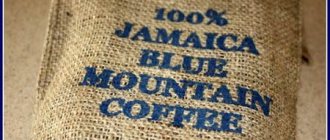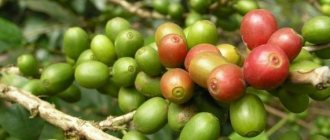Sombrero, salsa, a lost city and a river of five colors - we are used to identifying a country by some unique objects, architecture or objects of the animal world. And if some people single it out from the crowd (such as Russian nesting dolls, Italian pizza or German beer), others draw parallels with other cultures. Arabica coffee Colombia is one of them. Being a national treasure of Ethiopia and Brazil, for the South American country it is a certain component of the overall flavor. Although the 3rd place in the world in the production of coffee products (second only to the coffee of Brazil and Vietnam) and the high employment of the population in this type of activity cannot be ignored.
Brief introduction
Colombian coffee is a product made from beans from coffee trees grown in Colombia, a country in northwestern South America. This is where truly wonderful coffee is grown. The following factors contribute to this:
- The special humid climate in the mountainous regions of the country is ideal for coffee trees.
- Historically established traditions of plantation cultivation, passed down from generation to generation, thanks to which the secrets of agricultural technology are not available to outsiders.
- Improved varieties of coffee trees. A lot of attention is paid to this issue in the country, because this industry accounts for 4.7% of Colombia's GDP and provides jobs for a third of the population. Some unique plantations are protected by UNESCO.
The trade brand “Colombian Coffee” is prohibited by the laws of the country and the European Union to be used in relation to coffee grown outside the republic.
Historical facts
Coffee plantations began to be established in Colombia in the 17th century. During this period, the first written notes about coffee cultivation appeared. At the beginning of the 18th century, a commercial enterprise was created to obtain coffee raw materials. The records of the Jesuit monks speak about this. In the 19th century, other enterprises that collected and processed coffee beans appeared, but on a larger scale. One of them exported about 2.5 thousand bags of high-quality product from the country.
In the 20th century, Colombian coffee began to gain popularity. The growing interest in this product was due to its taste.
Colombian coffee has a unique taste due to the climatic conditions of the country and the composition of the soil of the regions
Excursion into history
Oddly enough, the cultivation of coffee trees in Colombia began not so long ago - only at the beginning of the 18th century. This matter was taken up by Jesuit monks from the Order of St. Ignatius, who arrived in South America to spread Christian teaching. The first mention of a new direction in agriculture was made by the Jesuit priest José Gumillo in 1730 in the book “Picturesque Orinoco”. Later, in 1787, Viceroy Archbishop Caballero y Góngora said in a report that the best coffee in Colombia was grown in the northeast of the country.
Still, a real commercial plantation was not organized until 1835. It is documented that the first harvest amounted to 2,560 60-kg bags. Compared to the production of tobacco, quinine, and meat, this was negligible, but planters saw the potential and persistently increased volumes. To protect their interests, large and small farms united in 1927 and created the National Federation of Coffee Growers of Colombia.
Today, up to 10 million bags of coffee beans are harvested annually in Colombia.
Production Features
A few facts:
- The total area of coffee plantations in Colombia is 940,000 hectares.
- The central region of Colombia, where most of the coffee is grown, visually resembles a triangle and is called the Colombian Coffee Cultural Landscape or Coffee Triangle.
- Some farms are located at an altitude of up to 1950 m.
- The harvest is harvested twice a year: from September to December and from April to June.
- Temperatures in the Coffee Triangle range from 8 to 24 degrees Celsius.
- In the north, the coffee is less acidic and full-bodied, while in the south it is more acidic and has a distinct, individual bouquet.
- The Colombian coffee industry employs more than 500 thousand farmers and creates more than 800 thousand jobs.
- Coffee plantations occupy 20% of all cultivated land in the country.
- Colombia accounts for 12% of the world's coffee. This is the third producer after Brazil and Vietnam.
- Due to global warming and climate change, the country's coffee industry is under threat.
Grain processing
In Colombia, coffee beans are cleaned exclusively using the wet method. First, twigs, leaves and debris are removed from the fruits of the coffee tree, then the skin and pulp. A thin parchment film remains on the grain; to get rid of it, the berries are fermented (usually it lasts no longer than one day). Then the future coffee is washed with plenty of water and the beans remain clean and smooth.
This is a relatively new and quite expensive technology (especially compared to the traditional “dry method”, in which the grains are simply dried in the sun). The coffee obtained in this way has a richer fruity taste, rich bouquet, and high quality.
Colombia grows only Arabica beans
There are few global productions in Colombia; a significant part of the coffee is produced by small farms that do not have the opportunity to purchase expensive equipment. Accordingly, most often the fruits of the coffee tree are picked here by hand, immediately discarding berries that are too small, damaged or diseased.
Cooking methods
Colombian coffee can be roasted to varying degrees of intensity. When the beans are lightly roasted, the drink will acquire sourness, notes of citrus, cocoa, and caramel. With medium and strong roasting, the coffee will be more intense with a rich bouquet. At the same time, Colombian varieties are so soft that even with strong “black” roasting, the coffee does not become bitter.
Colombians prepare their coffee in the following ways:
- In the coffee machine. Soft Colombian Arabica is ideal for espresso and drinks based on it (cappuccino, macchiato, etc.).
- In the aero press. The method is so popular that Bogota even hosts annual coffee brewing competitions this way.
- In the coffee maker on fire.
- Instant coffee. In Colombia, even instant coffee is of high quality - the residents of the country themselves drink it.
Famous brands of Colombian coffee
Don Pablo Colombian Supremo, Volcanica Colombian Peaberry, Coffee Bean Direct Colombian Supremo, Juan Valdez, Koffee Kult – Huila Coffee, Fresh Roasted Coffee, Eight o' Clock Coffee, San Francisco Bay Coffee, Sello Rojo, etc.
Why is Colombian coffee so valuable?
This product is considered elite and highly valued by gourmets all over the world. The rich and deep taste of the finished drink with a bright aroma is very popular among connoisseurs. Let's figure out why coffee beans from Colombia have such a high rating:
- coffee trees grow in climates that are ideal for them;
- plantations are located at an altitude of 1500-1800 meters above sea level, which allows you to grow real coffee;
- a combination of factors such as fertile soil, many sunny days, warmth and moderate humidity create all the conditions for harvesting large quantities of excellent quality crops;
- farmers work on family plantations for whom growing coffee has become the meaning of life;
- Until now, in Colombia, the process of cultivating coffee trees and harvesting mainly uses manual labor, so all the berries are collected as carefully as possible, carefully sorted and sorted;
- Product quality control is carried out by the local Federation of Coffee Producers.
Risks for the coffee industry in Colombia
One of the biggest risks for the industry is changing weather patterns due to climate change. Rising temperatures and unpredictable rainfall have a negative impact on bean production. Arabica beans, which make up the vast majority of Colombia's crop, are particularly vulnerable to climate change. This factor has also increased the prevalence of other major problems in the coffee industry: coffee rust and the insect pest coffee beetle. These dangers are now spreading to high mountain areas, where they can infect more plants and further reduce coffee yields.
How Colombian coffee beans are obtained
From 5 kg of raw grains, after processing, 1 kg of ready-to-eat grains is obtained. How does this happen?
Only in the third year after planting does the Arabian tree begin to bear fruit. The harvest is harvested by hand and several times per season, because the berries ripen unevenly. After picking, the berries are sorted, sorted, and cleaned of random impurities (twigs and leaves). Peel off the outer shell.
The raw materials are immersed under cold running water for at least 12 hours. The floating grains are removed as not ripe to consumer maturity. The remaining berries are then dried outdoors under the Colombian sun. After sufficient fermentation, the grains are sorted again and bagged as a finished product. This is how you get the best Colombian coffee!
States where coffee is grown
The main coffee producing states of Colombia are:
Cauca
The area where varieties such as Caturra are cultivated accounts for 64% of the coffee grown, Typica (21%) and Castillo (15%).
Tolima
The region where 74% of Caturra coffee is grown, 17% Castillo and 9% Typica. There are no large coffee plantations here; it is cultivated mainly by medium and small farms, which are united in cooperatives. This is due to the fact that the territory suffered greatly during the civil war.
Huila
A state that produces excellent coffee with fruity undertones. Here, more than 70 thousand farms are involved in the coffee industry, and about 16 thousand hectares are under plantations.
Quindio
Region located south of Bogota. Coffee production plays one of the primary roles in the state's economy. The importance of this product is evidenced by the various holidays held in its honor, the presence of theme parks and even the National Coffee Park.
Risaralda
One of the traditional coffee producing regions. The coffee industry employs a large part of the population and plays a leading role in the development of this territory. In addition, Risaralda is the most important transport artery of the country, because The roads of a number of coffee-producing states pass through it.
Nariño
The most mountainous state and, as a result, the most difficult to grow coffee. At the same time, the coffee cultivated here has excellent taste. The average farm size reaches 1 hectare. At the same time, there are those whose size exceeds 5 hectares.
Caldas
It is one of three states in Colombia where the bulk of Colombian coffee is produced. Senicafe is also located here, researching problems related to coffee, as well as conducting breeding work to create new varieties. Caldas is one of the regions where the highest quality coffee is grown.
Antioquia
One of the first departments in the country to start growing coffee. Today the state occupies a key position in the coffee industry. About 128 thousand hectares are used for coffee plantations here. Coffee is cultivated both on large plantations and in smaller coffee cooperatives.
Cundinamarca
The second region of Colombia that began to export coffee. Before the outbreak of World War II, coffee production accounted for 10% of the country's total coffee production. More than 1 million trees grew here.
Santander
The first state to begin exporting Colombian coffee. The presence of high mountains affects the taste of the coffee produced here. This is a smooth coffee with sweet notes. Most of the coffee grown in Santander is certified by the Rainforest Alliance.
Sierra Nevada
Low mountain region of Colombia. The coffee produced here is characterized by a fairly heavy but smooth taste.
Known varieties
The highest rated coffee beans from Colombia are various types of Arabica. The berries are collected from Arabian trees; the grains are distinguished by their elongated shape, smoothness and slight shine. Each grain is crossed in the middle by a curved line. Arabica is great for morning exercise. The following types of coffee are produced from it:
- "Bogota" - the variety is named after the capital of the republic. It is of very high quality. It costs expensive. The taste of the finished drink is not bitter and has an almond aroma.
- “Calambia Excelso” is a drink with a mild taste and barely noticeable bitterness, with a deep, rich aroma. Refers to products of the highest price category.
- “Bukamaranga” has an interesting banana flavor; you can hear notes of fragrant herbs in the coffee aroma.
- “Castillo” - coffee with a delicate taste acquires a nutty aftertaste if you add a little milk to the cup.
- “Narino” is one of the most popular varieties among consumers due to its successful combination of the highest quality and reasonable price.
- "Columbia" is the most famous variety in the world with a characteristic taste and aroma.
- “Opium” - the name best characterizes the drink, which is difficult to do without after the first try. The high price does not stop gourmets.
- “Caturra” is a sour drink for everyone.
Variety of varieties
Only Arabica beans are grown in Colombia. At the same time, it is classified according to varietal characteristics, as well as the size of the coffee beans. There are 3 main size types of Colombian coffee:
- Usually Good Quality. This type characterizes the smallest grains, the size of which does not exceed 5.5 mm.
- Excelso. The grains are slightly smaller - 6–6.5 mm.
- Supreme. The largest grains, their size ranges from 6.5–8 mm.
The Colombian coffee brand includes the following Arabica varieties:
- An old varietal species with low yields is Bourbon. It is characterized by a rich aroma, creamy aftertaste with notes of rye bread.
- Castillo is a hybrid variety characterized by a delicate taste with distinct sourness and a hint of bitterness. When mixed with milk it gives a nutty aroma.
- Typica is a basic variety, characterized by a classic coffee taste, light bitterness, and a delicate nutty aftertaste.
- Among the characteristics of the Caturra variety are high yield and fruit ripening activity. The drink made from such grains has pronounced sour notes and a faint caramel sweetness.
- Colombia - has a clear fruity sourness, sweet caramel taste, and cocoa aroma.
Unique coffee blends are created based on the listed varieties. The most popular among them are Columbia Supremo, Cafe Quindio, Columbia Maragogype beans. In addition to bean coffee, the ground product of the above varieties is also produced in Colombia.
Columbia Maragogype
Columbia Supreme
How to brew a drink correctly
Properly brewed Colombian coffee always receives rave reviews. Connoisseurs and lovers appreciate the drink for its balanced taste, richness and incredible aroma.
The grains should be ground finely and immediately before preparing the drink. Pour a heaping teaspoon of ground product into a preheated Turk. Pour 200 ml of cold water there. Keep over high heat until it starts to boil (the first bubbles should appear on the surface), immediately remove the Turk from the heat. Repeat the procedure 2-3 more times with an interval of 30 seconds.
Important! The drink should not boil during preparation, otherwise the real taste of Colombian coffee will be lost.
Rinse the cup with boiling water and pour the finished drink in a thin stream. Sweeten to taste with cane (brown) sugar.
Colombian Arabica coffee - a recipe with a local twist
It would be strange to find out if in a country that is one of the top three coffee producers, they prefer something else as a drink. Yes, they love coffee here and drink it with pleasure throughout the day. In the morning, this could be a cup of hot drink purchased from a street vendor for $0.5 - $1, or an espresso/Americano purchased in a cafe for $1 - $1.5. Wealthier citizens wait for the opening of elite coffee shops (they are open from 12.00) and buy a coffee drink there for every taste. The price for it ranges from $2 to $5.
Particularly popular is the so-called “tinto” – a cup of black coffee flavored with cane sugar. Despite the large volumes of coffee production in Colombia, most of it is exported abroad. That is why people here drink coffee drink more often than natural coffee. Be that as it may, the tradition of making real, delicious coffee has not bypassed this country. So, one of the unique ways to prepare coffee in Colombia is as follows:
- Heat an empty copper pot on the stove.
- Depending on the number of cups of hot drink you want, pour freshly ground coffee into it at the rate of 2 teaspoons of coffee powder per 1 coffee cup.
- Fill the coffee with water.
- Add sugar to taste.
- Place on the fire and bring to a boil.
- As soon as the coffee foam begins to rise, remove the drink from the heat.
- Coffee is poured into cups, and several coffee beans pre-dipped in melted chocolate are placed next to them on a saucer.
It is recommended to wash down every two sips of Colombian coffee with 1 sip of cold water. According to experts, this not only helps to fully reveal the aroma and taste of the drink, but also eliminates the possibility of heartburn and nausea. To ensure that coffee contains less caffeine, oxalic acid and purine bases, Colombian coffee is boiled only once.
Brand
Colombian coffee has proven itself in the world market only from the best side, therefore, since 2007, by decision of the European Commission, it has received the status of a “designation of origin controlled”.
Now the phrase “Colombian coffee” is a brand that sounds no less cool than “Portuguese port”, “French champagne” and “Italian Parmesan cheese”. We hope that this article was useful to you, we will be grateful if you share it with your friends on social media. networks. Have a nice day and see you again!











